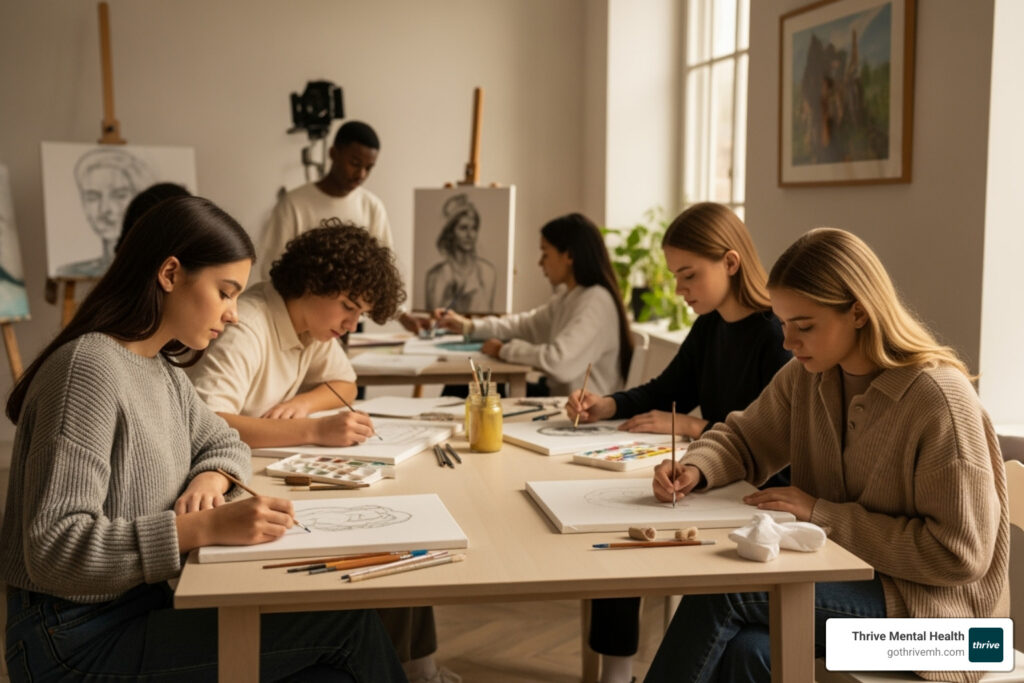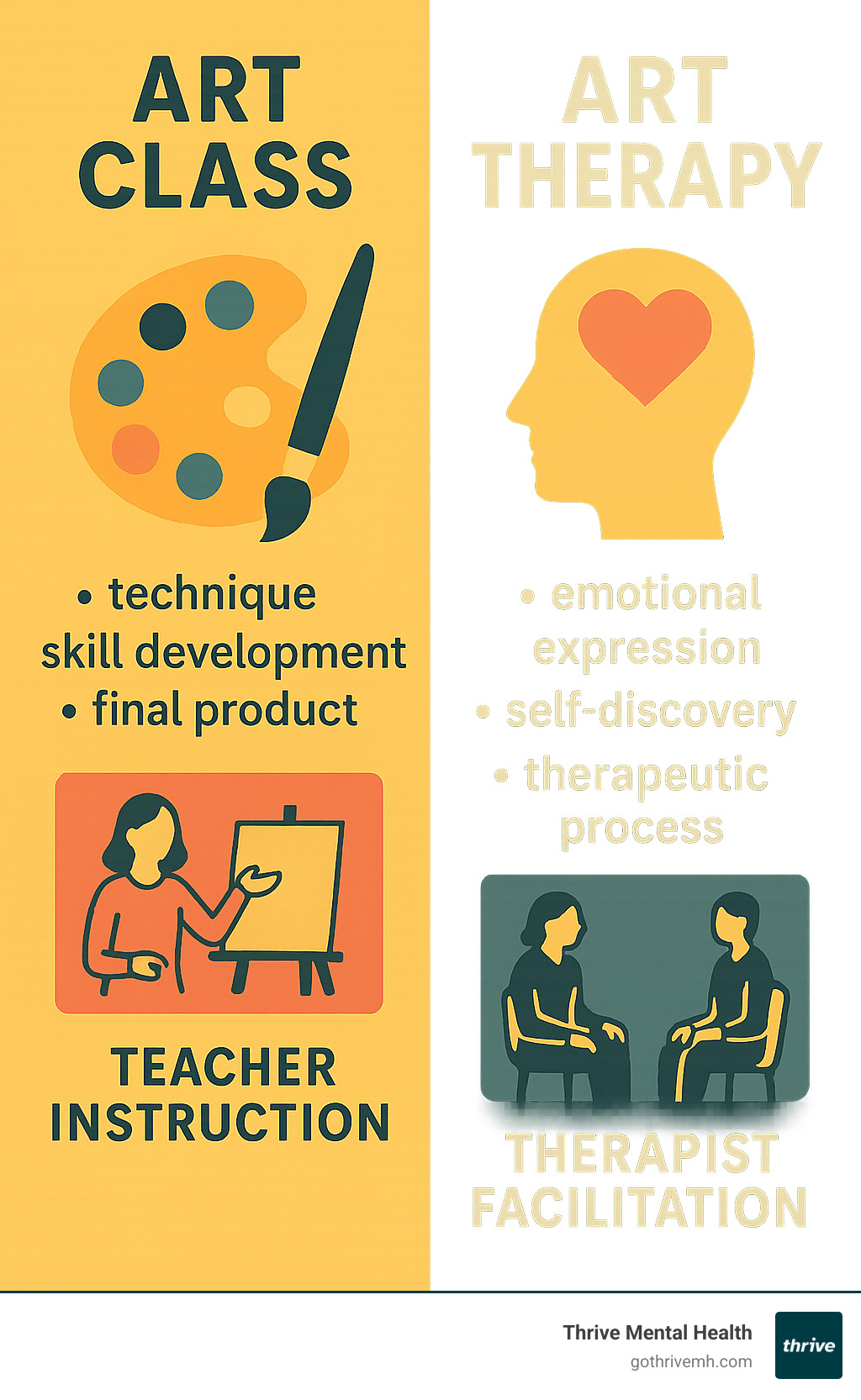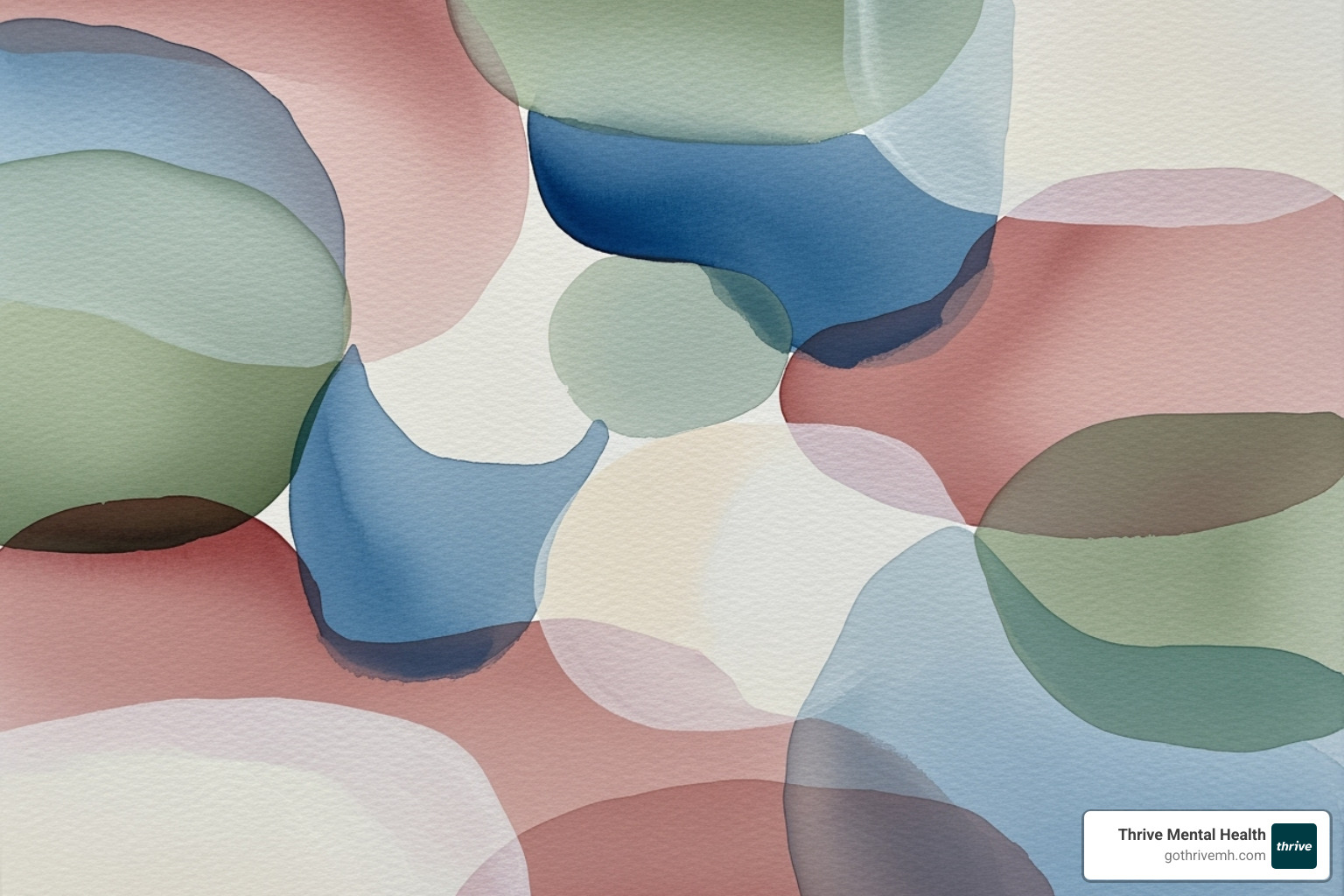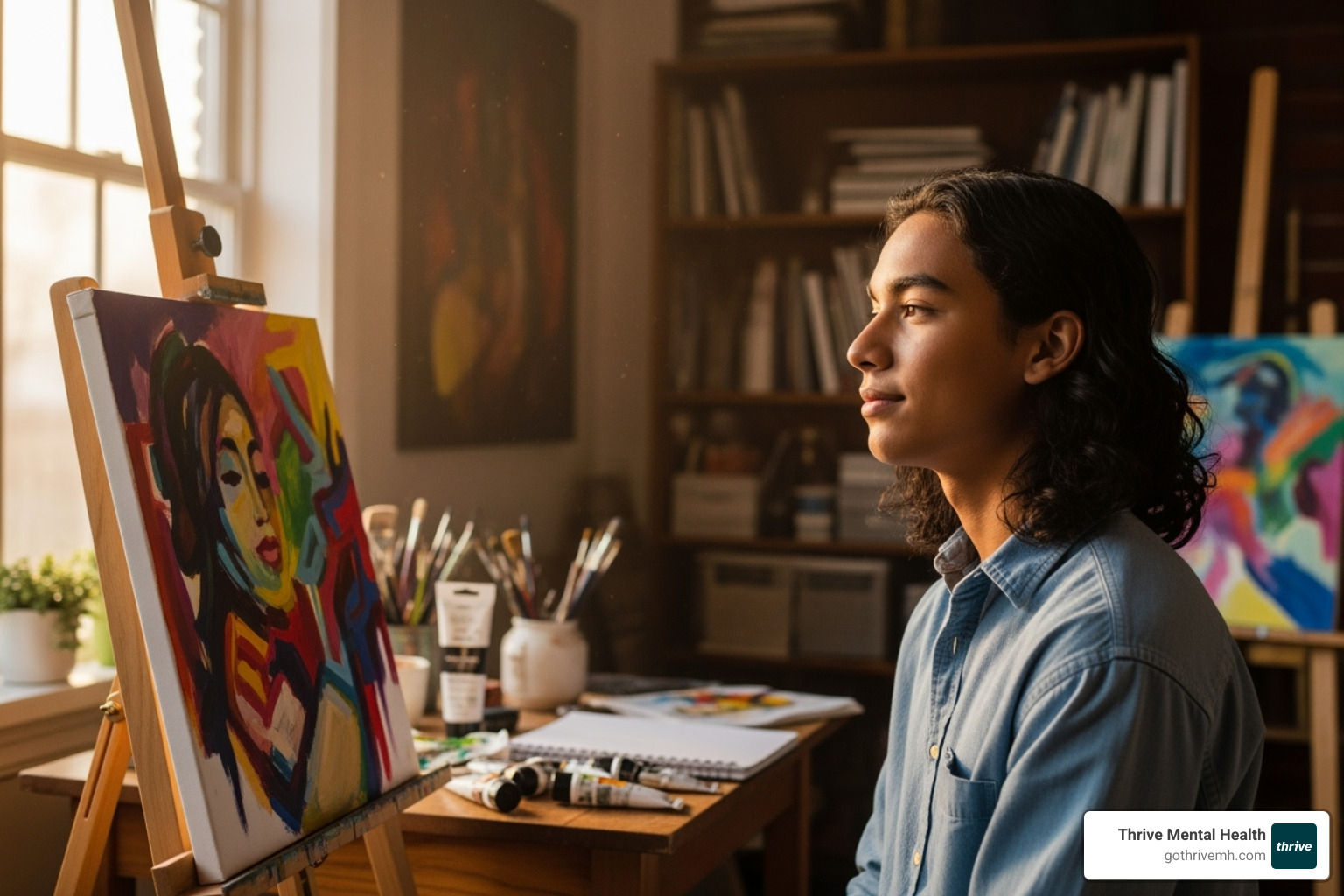The Ultimate Guide to Art Therapy for Teenagers: Benefits Explained

Why Art Therapy is Essential for Teen Mental Health
Art therapy for teenagers is a specialized form of psychotherapy that combines creative expression with mental health treatment to help adolescents process emotions, build self-awareness, and develop healthy coping skills.
Quick Answer: What is Art Therapy for Teenagers?
- Definition: A therapeutic approach using art-making (drawing, painting, sculpting) to explore feelings and experiences
- Focus: Process of creation, not artistic skill or final product
- Benefits: Emotional expression, stress reduction, improved self-esteem, better coping skills
- Who helps: Licensed art therapists trained in both psychology and creative techniques
- Conditions treated: Anxiety, depression, trauma, eating disorders, family conflicts
- No artistic experience required – the healing happens through the creative process itself
The teenage years bring intense physical, emotional, and social changes. While some teens thrive with traditional talk therapy, many find it difficult to put complex feelings into words. This is where art therapy becomes transformative.
Unlike regular art classes focused on technique and final products, art therapy creates a safe space for non-verbal communication. Research shows that imagery taps into our earliest ways of understanding the world, making it particularly powerful for adolescents still developing their emotional vocabulary.
When a 13-year-old draws two masks representing different sides of their experience, or when an anxious teen creates a collage about their fears, they’re accessing parts of themselves that might never surface in traditional conversation. The creative process itself becomes the pathway to healing.
As Nate Raine, CEO of Thrive Mental Health, I’ve witnessed how art therapy for teenagers breaks through barriers that often block traditional therapeutic approaches, creating breakthrough moments that reshape young lives. My experience leading behavioral health innovation has shown me that creative modalities often reach teens who’ve felt disconnected from other forms of treatment.

Art therapy for teenagers glossary:
Why Art Therapy is a Game-Changer for Adolescent Mental Health
The teenage years can feel like riding an emotional rollercoaster while blindfolded. One day your teen is confident and chatty, the next they’re withdrawn and overwhelmed. This isn’t just “typical teenage drama” – it’s the reality of adolescent development happening at lightning speed.
During these crucial years, teens are figuring out who they are while their brains are still under construction. The identity formation process is intense, complicated by peer pressure that feels life-or-death important and academic stress that never seems to let up. Meanwhile, their developing brains are wiring new connections, especially in areas that handle emotions and decision-making.
Here’s where things get tricky: many teens resist traditional talk therapy. It can feel intimidating, too “adult,” or like something’s seriously wrong with them. They might sit in a therapist’s office, arms crossed, responding with shrugs and “I don’t know” to every question.
Art therapy for teenagers changes this entire dynamic. Instead of demanding that teens find the perfect words for messy, complicated feelings, it invites them to express themselves through colors, shapes, and images. It’s like offering them a completely different language – one that feels natural and less threatening.
The beauty lies in non-verbal communication. When a 16-year-old can’t explain why they feel empty inside, they might draw a hollow tree. When anxiety feels too big for words, it becomes a tangled knot of red and black lines. This externalizing of internal stress helps teens see their struggles as something separate from themselves, rather than a fundamental flaw in who they are.
Research shows that art therapy with adolescents creates a safe outlet for difficult emotions that might otherwise stay trapped inside, potentially leading to more serious mental health challenges.
A Unique Language for Complex Feelings
Think about the last time you tried to describe a vivid dream or explain why a song made you cry. Sometimes words just aren’t enough. For teenagers dealing with trauma, depression, or anxiety, this limitation becomes even more pronounced.

Art therapy works by bypassing verbal barriers that often keep teens stuck in silence. When someone has experienced trauma or carries painful secrets, they might have been told “don’t tell” – but rarely “don’t draw.” This creates a unique opportunity for expressing trauma and secrets through imagery instead of words.
The magic happens through symbolism and metaphors. A teen might paint a storm to represent their parents’ divorce, or sculpt a fortress to show how they protect themselves from getting hurt. These artistic expressions aren’t puzzles for the therapist to solve – they’re the teen’s own way of making sense of inner chaos.
The process itself becomes healing. As teens create, they’re not just making art – they’re changing overwhelming internal experiences into something they can see, touch, and ultimately understand. More on the healing power of art reveals how this change creates lasting change.
Meeting Teens Where They Are Developmentally
Adolescence is essentially one long identity crisis – and that’s completely normal. Teens are caught between childhood and adulthood, bridging dependence and independence while their brains develop new abstract thinking abilities. Add in social pressures and academic stress, and it’s no wonder they sometimes feel overwhelmed.
Traditional therapy approaches often feel too much like another adult telling them what to do or think. Art therapy for teenagers flips this script entirely by creating a sense of control. When teens hold a paintbrush or mold clay, they’re in charge of what happens next.
This developmental alignment is crucial. Teenagers are naturally drawn to making their mark on the world – whether through doodling in notebooks, customizing their appearance, or even graffiti. Art therapy channels this natural urge into therapeutic expression.
The focus on process over product removes the pressure to be “good enough” that many self-conscious teens carry. There’s no right or wrong way to express feelings through art, which creates a rare judgment-free zone in their often-critical world.
By meeting teens exactly where they are developmentally, art therapy transforms what could feel like another adult obligation into something that actually feels engaging and empowering.
The Transformative Benefits of Art Therapy for Teenagers
When teenagers find they can transform their inner turmoil into something tangible and meaningful, something profound shifts. Art therapy for teenagers offers far more than creative expression—it becomes a pathway to healing that addresses the complex mental health challenges adolescents face today.

Research consistently shows that art therapy effectively supports teens struggling with anxiety, depression, PTSD, eating disorders, and substance use issues. What makes this approach particularly powerful is how it meets adolescents exactly where they are—often resistant to traditional talk therapy but eager to express themselves creatively.
The beauty of art therapy lies in its ability to work on multiple levels simultaneously. While a teen might think they’re simply painting or sculpting, they’re actually developing crucial emotional skills, building self-confidence, and learning healthy ways to cope with life’s challenges. Research shows art therapy reduces anxiety symptoms, with studies indicating that twice-weekly sessions create even more significant improvements.
Fostering Emotional Expression and Regulation
Picture a 16-year-old who’s been carrying anger from their parents’ divorce but can’t find the words to express it. Through art therapy, they might create a storm painting—dark swirls representing their rage, with small patches of light showing hope for the future. This process doesn’t just provide cathartic release; it helps them understand their emotions in a completely new way.
Many teenagers struggle with what therapists call “emotional vocabulary”—they know they feel bad, but they can’t pinpoint whether it’s sadness, frustration, disappointment, or something else entirely. Art therapy bridges this gap beautifully. When teens create an emotion color wheel, assigning different shades to various feelings, they develop emotional awareness that serves them for life.
The mindfulness aspect of art-making also provides powerful emotional regulation benefits. Simple activities like creating paper beads or mindful coloring activate the same calming responses as meditation. These techniques help teens manage anger and frustration in the moment, giving them tools they can use anywhere—whether they’re stressed about a test or dealing with friendship drama.
At Thrive Mental Health, we’ve seen how consistent creative expression helps Florida teens develop these essential emotional skills. You can explore therapeutic activities for teens to see how we integrate these approaches into our programs.
Building Self-Esteem and a Positive Identity
Nothing builds confidence quite like creating something with your own hands. In art therapy for teenagers, every brushstroke, every sculpture, every collage becomes an act of self-findy and accomplishment. Unlike academic subjects where there are right and wrong answers, art therapy celebrates the uniqueness of each teen’s perspective.
Consider a shy teenager who’s always felt overlooked. When they create a self-portrait mask showing their “hidden strengths” on the inside, they’re not just making art—they’re exploring personal values and recognizing qualities they never knew they possessed. This process helps them develop problem-solving skills as they figure out how to represent abstract concepts visually.
The sense of accomplishment that comes from completing an art project is particularly meaningful for teens who might be struggling academically or socially. They can look at their creation and say, “I made this. This came from me.” That tangible proof of their capability becomes a foundation for positive self-image.
Art therapy also provides a safe space for teens to experiment with different aspects of their identity. Through creating vision boards, designing personal symbols, or even just choosing colors that represent their mood, they’re actively engaged in the crucial adolescent task of finding unique talents and figuring out who they want to become. A review on art therapy’s role in promoting mental health explores how this identity exploration contributes to overall well-being.
Developing Healthy Coping Skills and Resilience
Life hits hard sometimes, especially when you’re a teenager. Art therapy equips teens with a diverse toolkit of stress reduction techniques that they can use throughout their lives. Instead of turning to unhealthy behaviors when overwhelmed, they learn to channel difficult emotions into creative expression.
The grounding exercises embedded in art-making are particularly valuable. When anxiety strikes, a teen might create worry stones from clay, focusing on the texture and repetitive motions to calm their nervous system. These techniques provide immediate relief while building resilience for future challenges.
What’s remarkable about art therapy is how it transforms pain into power. Rather than letting difficult emotions fester internally or explode outwardly, teens learn to direct their feelings into their artwork. A teenager dealing with depression might create a series of paintings showing their journey from darkness toward light, creating tangible reminders of strength they can revisit whenever they need encouragement.
The self-regulation skills developed through art therapy extend far beyond the therapy room. Teens learn to recognize their emotional states, understand their triggers, and respond thoughtfully rather than reactively. These capabilities serve them well in relationships, academics, and eventually in their careers.
Our virtual programs at Thrive Mental Health make these powerful coping strategies accessible to teenagers throughout Florida, meeting them where they are and supporting their growth in flexible, innovative ways. You can learn about mental health art activities that specifically support resilience building.
What to Expect in an Art Therapy Session
Walking into an art therapy for teenagers session might feel different from what you’d expect from traditional therapy. There’s no intimidating couch or formal interview setup. Instead, you’ll find a welcoming space filled with art supplies, natural light, and an atmosphere that invites creativity rather than judgment.
Sessions can happen one-on-one, which allows for deep personal exploration, or in small groups where teens find they’re not alone in their struggles. Whether your teen connects better in individual sessions or finds strength in shared experiences, the environment remains consistently safe, confidential, and free from criticism.

The beauty of art therapy lies in its flexibility. Some days might involve quiet, reflective work with watercolors. Other sessions could be more energetic, with clay sculpting or collaborative murals. Each session adapts to where your teen is emotionally that day, making it a truly personalized healing experience.
The Role of the Art Therapist
Here’s something that surprises many parents and teens: an art therapist isn’t an art teacher. They’re trained mental health professionals who understand both the creative process and how the mind heals. Think of them as skilled guides who help your teenager steer their inner world through creative expression.
The art therapist’s job isn’t to teach painting techniques or critique artistic ability. Instead, they create a bridge between what your teen creates and what they’re experiencing inside. They might ask gentle questions like “What was it like creating this piece?” or “What story does this artwork tell about your week?”
Most importantly, the therapist never interprets the artwork for your teen. The meaning, insights, and connections come from your teenager themselves. This approach builds trust and ensures that any breakthroughs feel authentic and empowering rather than imposed by an adult.
The therapist carefully selects materials and suggests activities based on your teen’s specific needs and therapeutic goals. They’re trained to notice when someone might benefit from the soothing repetition of weaving versus the emotional release that comes from working with clay. For a deeper understanding of this therapeutic approach, explore a comprehensive guide to art therapy.
Common art therapy activities for teenagers
The activities in art therapy for teenagers go far beyond basic drawing and painting. Art therapists choose projects that feel engaging and contemporary, often surprising teens with their variety and relevance to their lives.
Collage and vision boards let teens cut, arrange, and layer images from magazines to explore their dreams, fears, or values without needing to draw a single line. Mask making becomes a powerful way to explore the difference between how they present to the world and how they feel inside.
Working with clay offers something completely different—a chance to pound, squeeze, and shape emotions into three-dimensional form. Many teens find this especially helpful for processing anger or frustration. Emotion paintings use colors and abstract shapes to make feelings visible, while “safe place” drawings or boxes create tangible reminders of security they can return to during difficult times.
Some of the most meaningful work happens through self-portraits that go beyond mirrors—teens might paint how anxiety feels in their body or create a comic strip about a challenging experience. Group murals build connection and communication skills, while simple doodling sessions help anxious minds settle and focus.
Music-inspired art combines two powerful forms of expression, and creating worry beads or mindfulness objects gives teens something tangible to hold during stressful moments. Even T-shirt painting becomes therapeutic when teens use it to express their identity or values.
The key is that none of these activities can be judged as “good” or “bad” art. The healing happens in the creating, not in the final product. You can see more art therapy activities for adolescents to understand the full range of possibilities.
Creating an Inclusive and Safe Space for all teenagers
Every teenager deserves to feel welcome and capable in therapy, regardless of their abilities, learning differences, or personal challenges. Creating truly inclusive art therapy for teenagers means thinking carefully about how each individual can best engage with the creative process.
For teens with physical disabilities or visual impairments, adaptive tools make all the difference. This might mean paintbrushes with larger grips, textured materials that provide sensory feedback, or digital art tools that work with assistive technology.
Sensory-friendly environments benefit many teens, especially those with autism or ADHD. This means thoughtful lighting, manageable noise levels, and comfortable seating that helps rather than distracts from the therapeutic work. Whether sessions happen in person in Florida or through our virtual programs, these considerations remain essential.
Respecting individual preferences goes beyond accommodations—it’s about recognizing that one teen might thrive with watercolors while another needs the resistance of charcoal on paper. Some teens jump right into activities, while others need time to observe and build trust.
Flexible session structures acknowledge that healing doesn’t happen on a timer. Some teens need longer to process their creations, while others work quickly and benefit from multiple shorter activities within a session.
Our therapists use clear, encouraging language that consistently reinforces the message: artistic skill is never required, and every form of expression is valuable. This creates the psychological safety necessary for genuine therapeutic work to happen.
By tailoring each aspect of the experience to individual needs, we ensure that art therapy becomes a powerful tool for every teenager who walks through our doors—or logs into our virtual sessions from anywhere in Florida.
Frequently Asked Questions about Art Therapy for Teens
As parents and teens explore art therapy for teenagers, we often hear the same thoughtful questions. It’s natural to want to understand how this unique approach works and whether it’s right for your situation. Let’s address the most common concerns we encounter.
Can art therapy replace traditional therapy?
This is one of the most important questions we hear, and the answer is both yes and no—it really depends on your teen’s specific needs and circumstances.
Art therapy is a powerful modality that can absolutely stand on its own for many teenagers. In fact, for teens who are resistant to traditional talk therapy or struggle to put their feelings into words, art therapy can be the perfect primary treatment approach. We’ve seen countless young people who felt stuck or frustrated with conventional therapy find their breakthrough moment through creative expression.
However, art therapy also works beautifully to complement other therapeutic approaches. Many of our clients at Thrive Mental Health benefit from combining art therapy with techniques like Cognitive Behavioral Therapy (CBT) or Dialectical Behavior Therapy (DBT). This integrated approach can be incredibly effective, giving teens multiple pathways to healing.
The decision ultimately depends on individual needs and goals. Some teens thrive with art therapy as their main treatment, while others find it most helpful as part of a broader therapeutic plan. Your art therapist will work with you and your teen to determine what combination feels right and most effective.
Does my teen need to be “good at art” to benefit?
Absolutely not! This might be the biggest myth about art therapy for teenagers, and we love clearing this up for families.
Here’s the beautiful truth: the focus is on the creative process and self-expression, not on making museum-worthy masterpieces. Your teen doesn’t need to know how to draw a perfect circle or paint like Picasso. In fact, some of the most powerful therapeutic breakthroughs happen through simple stick figures, abstract scribbles, or collages made from magazine clippings.
There is no “good” or “bad” art in therapy. Our therapists create a completely judgment-free zone where your teen can experiment, play, and express themselves without worrying about artistic skill. The magic happens in the choosing of colors, the feel of clay in their hands, the bold stroke of a paintbrush, or even the gentle scratching of a pencil on paper.
The therapist creates a judgment-free zone where the messiest, most “imperfect” artwork often reveals the most profound insights. We’ve seen teens who were convinced they “couldn’t draw” create pieces that perfectly captured their emotions and helped them understand themselves in completely new ways.
What mental health issues can art therapy help with?
Art therapy for teenagers is remarkably versatile, addressing a wide range of mental health challenges that teens face today. Its non-verbal, creative approach makes it especially effective for issues that feel too big, scary, or complicated to talk about directly.
Anxiety disorders respond beautifully to art therapy. When teens create worry sculptures, draw their anxious thoughts, or make calming collages, they’re learning to externalize and manage their fears. Research consistently shows significant reductions in anxiety symptoms through creative expression.
For depression, art becomes a gentle way to explore heavy feelings without the pressure of finding the right words. Teens can paint their sadness, sculpt their hopes, or create vision boards that help them imagine brighter futures.
Trauma and PTSD often involve experiences that feel impossible to verbalize. Art therapy provides a safe container for processing these difficult memories through imagery, symbolism, and metaphor, allowing healing without re-traumatization.
Eating disorders and body image issues can be explored through self-portraits, body mapping, and creative expression around identity and self-worth. Art helps teens develop a healthier relationship with their bodies and themselves.
ADHD symptoms often improve through the focused, hands-on nature of art-making. The structured creativity helps with attention, self-regulation, and executive functioning skills.
Family conflict can be addressed through family art therapy sessions, where visual expression helps everyone communicate more clearly and understand different perspectives.
Beyond specific diagnoses, art therapy excels at helping with stress management, identity formation, self-harm behaviors, and substance use issues. It provides healthy coping skills and builds resilience that serves teens well beyond their therapy experience.
At Thrive Mental Health, our virtual and in-person programs throughout Florida integrate these creative approaches because we’ve seen how transformative they can be for young people facing any of these challenges.
Conclusion: Finding a Path to Healing Through Creativity
The teenage years don’t have to be something to simply survive. While adolescence brings its share of storms, it’s also a time when young people can find incredible strength, creativity, and resilience they never knew they had. Art therapy for teenagers offers something truly special—a bridge between the chaos of growing up and the peace that comes from understanding yourself.
Throughout this journey, we’ve explored how art therapy goes far beyond creating pretty pictures. It’s about giving teens a voice when words fail them. It’s about helping a anxious 16-year-old realize they can literally paint their worries away, or watching a depressed teen light up when they create something that reflects their inner world. The magic happens not in the final artwork hanging on a wall, but in those moments when a young person finds they have the power to express, heal, and grow.
Art therapy for teenagers meets young people exactly where they are developmentally. It doesn’t ask them to be more verbal than they’re ready for, or more emotionally mature than their brain development allows. Instead, it says, “Come as you are, and let’s create something meaningful together.” This approach has proven transformative for teens dealing with anxiety, depression, trauma, and countless other challenges that make the teenage years feel overwhelming.
The benefits we’ve discussed—emotional expression, improved self-esteem, and healthy coping skills—aren’t just therapeutic buzzwords. They’re real changes that happen when teens are given the right tools and support. When a teenager learns they can manage their anger through clay sculpting instead of lashing out, or finds their worth through creating a vision board of their dreams, they’re building skills that will serve them for life.
For families in Florida seeking this kind of comprehensive support, Thrive Mental Health understands that every teen’s path to healing looks different. Our virtual and in-person programs recognize that some young people need the flexibility of online sessions, while others thrive in face-to-face environments. What matters most is meeting each teenager where they are and providing the expert-led, evidence-based care that helps them flourish.
If you’re ready to explore how creativity can become a pathway to healing for the teenager in your life, we’re here to help. Our team believes deeply in the transformative power of art therapy, and we’ve seen how it can change young lives. You can explore our virtual art therapy programs to learn more about how we can support your teen’s journey toward emotional well-being and a brighter, more confident future.